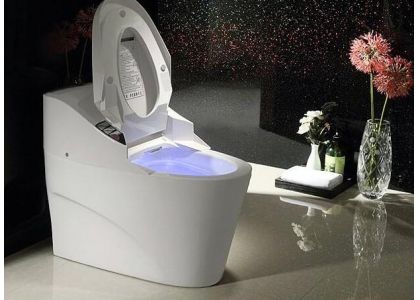INDUSTRY NEWS
How To Choose A Smart Toilet

1. Smart toilet introduction
The smart toilet originated in the United States for medical and geriatric care, initially with a warm water wash function. After South Korea, the Japanese sanitary ware company gradually introduced technology to manufacture, and added a variety of functions such as heat cover heating, warm water washing, warm air drying, and sterilization. At present, smart toilets on the market are generally divided into two types, one is a smart toilet with cleaning, heating, sterilization, etc., and the other is a smart toilet that can automatically change the film.
2 Intelligent toilet working principle
The working principle of the intelligent toilet is mainly the principle of siphon. For example, if the water is filled with the upward and downward bends, the water falling down the pipe will be together with the water on the other side of the bend (that is, the part of the water you see). Roll over the upward bend and pull it down. This up and down bend is something that is not easy to see on the outside and is hidden inside. The water in the bucket is higher than the water in the bucket. The water outlet of the pipe is lower than the bottom of the toilet. The water inlet of the pipe is directly in the bottom of the bucket, so that the water in the bucket will follow the pipe. Turn over the edge of the barrel higher than the liquid level and flow to the lower part of the barrel, that is, go up and down, and the water in the barrel will flow completely. This is the phenomenon of siphoning.
3 How to choose a smart toilet
New generation smart toilet foam shield and super light shield series
1) Not as many functions as possible: Many consumers will feel that the more features they have when purchasing a smart toilet, so that they can get the best value for money. In fact, a smart toilet should choose the right function according to its own needs. A smart toilet needs to be equipped with human body sensing, seat heating, warm water washing, mobile washing, warm air drying. Automatic deodorization and one-button energy-saving technology basically meet the needs of the general consumer. Then consumers can choose another functional experience that suits their own and their family according to their specific needs, so that they will not blindly purchase smart toilets and put them home instead of being practical.
2) Real water saving: See if the smart toilet is really water-saving. In addition to seeing the water consumption, the flushing rate, the flushing distance, and whether the water seal is effective or not can not be ignored. For example, if a smart toilet with a small amount of water is used, if the flush rate is insufficient, it will not be cleaned once and it needs to be washed twice or three times. The “water saving” becomes a fee. Generally speaking, the qualified water-saving intelligent toilet has the water-saving certificate issued by the state; in the water-saving configuration of the water-saving intelligent toilet, the larger-diameter drain valve can achieve rapid drainage effect; the qualified water-saving toilet is guaranteed At the same time of the sewage function, it is necessary to have a S-pipe and a water seal in accordance with national standards to achieve the purpose of deodorization.